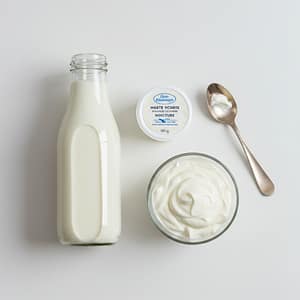- Home
- Yogurt

I. General Information
A. Scientific Name:
Fermented milk with Lactobacillus delbrueckii subsp. bulgaricus and Streptococcus thermophilus
B. Alternative Names:
Yoghurt, Dahi (India), Cuajada (Spain), Laban (Middle East)
C. Pronunciation:
/ˈjoʊɡərt/
II. Sourcing and Origin
A. Source:
Milk (cow, goat, or sheep)
B. Geographic Origin:
Ancient Mesopotamia, with evidence of its consumption dating back to 5000 BC.
C. Method of Processing:
Milk is heated to a specific temperature and then cooled. A starter culture containing the beneficial bacteria is added, and the mixture is incubated in a warm environment for several hours, allowing the bacteria to ferment the lactose, thicken the milk, and create its characteristic tangy taste.
III. Properties and Uses
A. Physical Properties:
A thick, creamy food with a tangy flavor. Consistency varies from a liquid (drinkable yogurt) to a very thick, strained form (Greek yogurt).
B. Chemical Composition:
Rich in probiotics (Lactobacillus and Bifidobacterium species).
Vitamins: B2 (riboflavin), B12, D (fortified), A.
Minerals: Calcium, magnesium, potassium, phosphorus.
Contains proteins (casein, whey) and bioactive peptides.
Natural lactic acid from fermentation.
C. Primary Uses:
Skincare: Used in face masks for soothing, exfoliating (lactic acid), and moisturizing effects.
Haircare: DIY hair masks use yogurt for shine, hydration, and scalp soothing.
Wellness: Supports gut health, digestion, and immunity; promotes bone strength; aids weight management; may reduce risk of heart disease.
Culinary: Enjoyed as a snack, smoothie base, in dressings, dips, curries, baked goods, and desserts.
Household/Industry: Used in probiotic supplements, dairy products, and functional foods.
D. Key Benefits:
Excellent source of protein and calcium, supports bone health, and aids digestion.
IV. Safety and Considerations
A. Potential Allergies:
Not suitable for individuals with a milk allergy.
B. Best Practices for Use:
Look for "live and active cultures" on the label to ensure it contains probiotics.
C. Special Precautions:
Generally safe for most people.
Dairy-based yogurt unsuitable for those with milk allergies.
Lactose-intolerant individuals may tolerate yogurt better than milk due to fermentation.
Sweetened yogurts may contain added sugar, reducing health benefits.
V. Fun & Educational Facts
A. Historical Context:
It is believed that yogurt was discovered by accident when milk carried by nomadic tribes was fermented by bacteria in their warm travel sacks.
B. Did You Know?
Greek yogurt is made by straining out the whey, resulting in a thicker consistency and a higher protein content.
C. DIY Recipe Idea:
Yogurt is a versatile ingredient in many dishes, including parfaits, smoothies, and marinades for meat.
